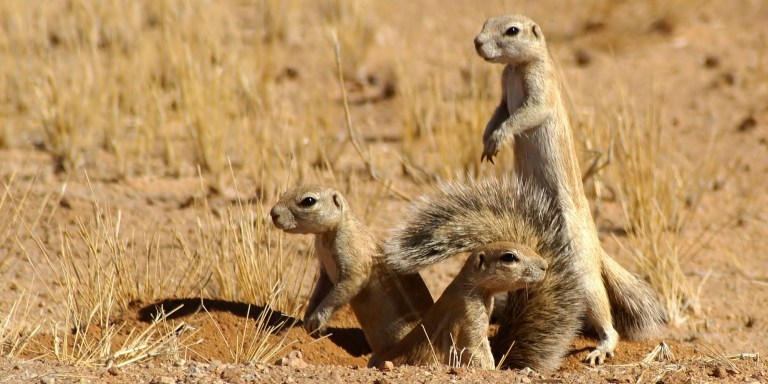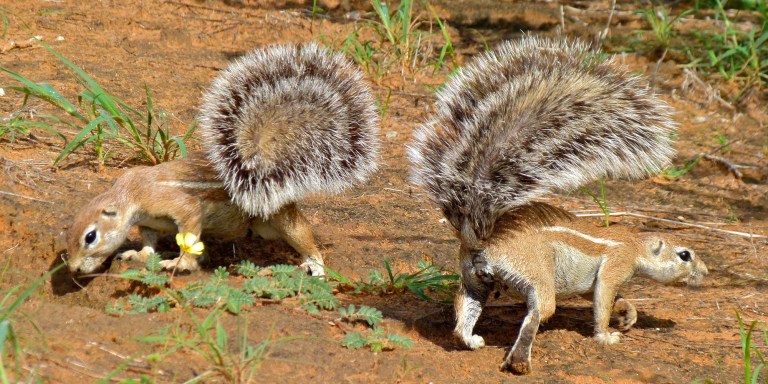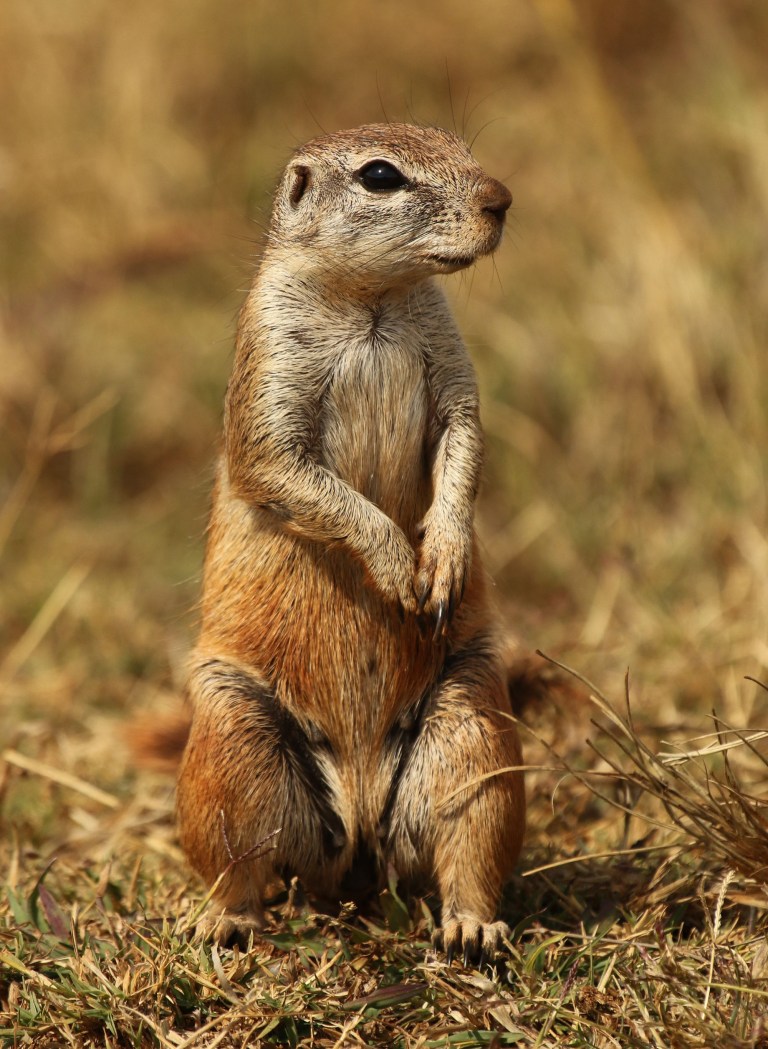
Cape Ground Squirrels emerge from communal burrow, close to Solitaire in the Namibian desert, Namibia. (Photo: Hans Hillewaert
By Rebecca Davis | 11 Jan 2023
There is growing evidence that animals’ bodies and habits are changing as global temperatures rise. Now Canadian researchers have found that we may have an example of this on our doorstep. Over almost two decades of climate warming, the Cape ground squirrel is subtly changing shape.
____________________________________________________________________________________________________________
At a nature reserve in North West, the maximum daily temperature has increased by about 2.5 °C over the past 18 years.
That might not sound like much — but it’s enough for the animals in this ecosystem to start changing shape.
This is the extraordinary finding of University of Manitoba researchers Miya Warrington and Jane Waterman, in a paper published in the Journal of Mammalogy late last year. “Temperature-associated morphological changes in an African arid-zone ground squirrel” records the physical changes observed in Xerus inauris, the Cape ground squirrel, as the temperature rises.
Shape-shifting in response to climatic warming
There is a growing body of evidence that climate change is causing the “ecology, life histories and physiology” of animals to change, Warrington and Waterman write.
This is likely to be happening because animals have to keep their body temperature within an acceptable range. Species which can’t achieve this, the researchers note, face problems ranging from reduced cardiovascular fitness to death.
The paper cites a number of other changes in body morphology which have been recorded by other researchers in recent years. They include increased bill sizes among birds, longer ear lengths in wood mice, larger ears in European rabbits and larger appendage sizes in masked shrews.
Although the changes are small, US ecologist Casey Youngflesh — who has recorded shrinking body sizes in 80 species of birds over the course of three decades — recently pointed out that most evolutionary changes take place across geologic timescales.
Youngflesh told The Scientist: “Seeing these sorts of changes over such a rapid timescale — it’s a little shocking.”

Ground squirrels in the Auob River Bed, Kgalagadi Transfrontier Park, South Africa. (Photo: Wikipedia. Bernard Dupont)
How the local squirrel study worked
Warrington and Waterman’s research is part of a long-term study carried out at SA Lombard Nature Reserve near Bloemhof in North West, which started in 2002 and continues to date, with the exception of a three-year hiatus between 2007 and 2010.
Because the study records daily temperatures and rainfall in addition to data about the Cape ground squirrel, the researchers were in an excellent position to look at longitudinal changes to the climate and corresponding changes to squirrel physiology.
When it came to the temperature records for the 18 years under observation, they found “strong evidence that daily maximum temperature and daily minimum temperature increased with [the] year”: to the tune of around 2.5 degrees.
The scientists “found no evidence that rainfall conditions changed with year; however, seasonal rainfall fluctuates throughout the years”.
They knew that Cape ground squirrels already have a number of tactics for dealing with temperature challenges. They sleep in groups for warmth in clusters of burrows; they use their bushy tails as shade from the sun. Sprawling flat on the ground with their limbs splayed — a practice delightfully known as “splooting” — can also help bring relief from the heat.
But could anything have happened to the squirrels’ body morphology to help assist them with the ever more intense daily temperatures?
The study saw squirrels lured to traps baited with birdseed and peanut butter. (Squirrels love peanut butter, Warrington confirmed to Daily Maverick this week.) Then they were weighed, measured, and released.
The results: over 18 years, the bodies of Cape ground squirrels have indeed changed.
“Absolute and proportional hindfoot size increased with time, while spine length decreased,” the researchers wrote. In layman’s terms: the squirrel’s feet are getting bigger, and their spines are getting shorter.
This may seem counter-intuitive. One might assume that in response to hotter ground temperatures, it would serve squirrels better to have a smaller, rather than larger, foot area. But it is theorised that their already very large hind feet actually serve to dissipate heat from the squirrels’ bodies.
Or, to quote the researchers: “Increased proportional hindfoot sizes in Cape ground squirrels may be related to the thermoregulatory advantages of larger appendages in the warmer ambient temperatures measured at our field site.”
These results are similar to the pattern observed in Youngflesh’s bird study, where growing beak sizes were recorded — apparently because “having a bigger surface area allows [bird bills] to dissipate more heat passively”.

Cape ground squirrel, Xerus inauris, at Krugersdorp Game Reserve, Gauteng, South Africa. (Photo: Wikipedia / Derek Keats)
What do these findings mean?
The researchers wrote that these changes in the Cape ground squirrel “provide evidence in support of ‘shape-shifting’ in response to climatic warning”, adding to “the growing evidence that animal morphologies are changing in response to changing climatic conditions”.
Importantly, however, they also write: “It remains to be seen whether these changes are adaptive.”
Warrington explained to Daily Maverick that the study should be considered “correlational”.
She said: “We saw a pattern of larger feet and shorter spines at the same time that temperatures increased at our field site. This means that even though we saw these body changes, we cannot yet tell if these changes translate into the squirrels being better able to keep themselves cool.”
Asked if it was likely that human physiology might also undergo changes in response to the warming climate, Warrington said that the question was complex: “It depends on whether there is a strong link between the consequences of climate change and the capacity of human physiology to respond.”
What should no longer be questioned, however, is that the effects of climate change are becoming very real — and research of this kind is becoming ever more important.
Write Warrington and Waterman: “As species that are able to respond quickly to environmental changes are more likely to survive the rapid human-driven land-use changes and climatic changes projected for the coming centuries, understanding how species and populations respond to change in climatic conditions is important in predicting which species will be resilient to climate change.” DM/OBP
https://www.dailymaverick.co.za/article ... te-change/


